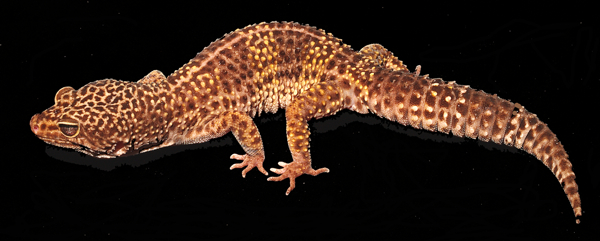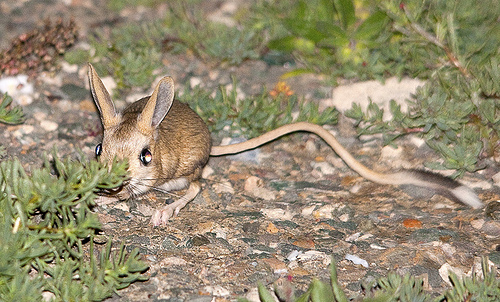[ad#superworm]
I chose to write an article on whether or not it is “OK” to feed pinkie mice to adult leopard geckos. Not only have I had experience with feeding pinkie mice, but I have also contacted herpetoculturist Ron Tremper. Ron Tremper is the former curator of reptiles at the Chaffee Zoological Gardens (Fresno, Ca) and is a world recognized authority on the selective breeding of leopard geckos.
First, I will state that every breeder and or pet owner has the right to their own opinion on whether or not they want to feed their adult leopard geckos pinkie mice.
Pros and Cons of Feeding Pinkies
Below is an example of a one day old mouse. According to Ron Tremper’s books and an e-mail he had written to me, he states:
1)feeding one pinkie mouse a week to laying females helps maintain their body weight and nutrition.
“energy in = energy out”
2)excessive feeding of pink mice often caused intestinal gout and obesity.
Therefore I would suggest if you choose to use pinkie mice please do so with caution and understand the risks. Any time I have fed pinkie mice to my leopard geckos I have always kept an eye on them, making sure they are continuing to have normal bowel movements. I also watch my geckos eat them to be sure they are able to swallow the pinkie mouse without a problem. Normally, you should not have a problem with this, however, it is better to be safe than sorry. I personally would not give my laying females any more than two pinkie mice a month. Ron Tremper does state, though, that it is “OK” to give your laying females one pinkie mouse a week to help maintain their weight and nutrition.
Pinkie mice I have found are also useful not only in helping maintain the weight of a gravid female but also in major growth spurts. I would make sure the pinkie mouse is small enough to allow a young (but large enough) gecko to swallow it without difficulty. Pinkie mice have been found to be too fatty as a staple (everyday) food source. As I stated above Ron Tremper says: “excessive feeding pink mice often caused intestinal gout and obesity.” Several breeders on their web sites have stated that they have seen fatty liver disease as a result of eating pinkie mice.
Other Feeding Alternatives
Some breeders and pet owners prefer to not use pinkie mice at all for various reasons. You can also offer your leopard geckos a large number of different supplements and worms to help maintain their body weight. Waxworms, mealworms, super worms, phoenix worms, silk worms, and horn worms are just a few to mention. I have seen that some breeders like to offer their geckos May Flies. Here is a link to Wikipedia’s information about this insect: Mayfly.

Leopard geckos are insectivores. This means that they mostly feed on crickets, wax worms, mealworms, super worms, and other insects that they may find in their natural environment (the deserts of Asia and Afghanistan, throughout Pakistan and some parts of northwestern India). If the gecko happens to find a mouse nest, they may eat a newborn mouse. Some of the different mice a gecko might eat in Pakistan are the Ward’s Field Mouse, Kashmir Field Mouse, Hotson’s Mouse-Like Hamster, and Baluchistan Pygmy Jerboa.

Above is a close example of a Baluchistan Pygmy Jerboa.
The majority of captive leopard geckos will refuse to eat dead prey. However, I have a few geckos that will eat freeze dried crickets. In fact I have one female that will sit and eat all day long if I leave freeze dried crickets in her cage. If you are able to get your gecko to eat freeze dried crickets you will develop a back-up feeding option in unexpected times when you are unable to obtain live food for them. Crickets are the most common food source to give to leopard geckos as they can hunt them in their cage the way they would in their natural environment. The choice to feed your Gecko pinkie mice is your own.
References:
- Hamper, R. (2004). The Leopard Gecko, Eublepharis macularius, in Captivity. MI: ECO Herpetological Publishing & Distribution. pp. 1–80.
- Bartlett, R.D.; Bartlett, Patricia (1999). Leopard and Fat-Tailed Geckos. Barron’s Educational Series, Inc. pp. 26–27. ISBN 0-7641-1119-1.
- Tremper, Ronald (2012). Leopard Gecko.com www.leopardgecko.com
Lead photo property of Maggie Boyle Photography, licensed under creative commons.


Hi I just read this and saw it about lepord gecko but what I would like to know is can a day gecko eat a pinkie if it was or will it eat one
Most day geckos are quite small, too small to eat a pinkie. The largest day gecko is the P. grandis and I wonder if its mouth may be too small to accommodate one.
I have been feeding my gecko crickets and pinkies regularly. But something odd happened. My gecko wouldn’t eat one of the three pinkies. So I just left it in there waiting for her to eat it. But the crickets ate it alive. Do I avoid this orrr… what do I do?
I have to say, this is one reason I don’t feed my geckos pinkies because I don’t want to deal with the situation where the gecko doesn’t want it. Your choices (besides not feeding pinkies which I don’t think are really necessary for leopard geckos) are to let the crickets have it or to watch carefully and if it’s rejected to either feed it to something else, to give it to someone else that can use it or, if you’re feeding live pinkies, to plan to have a pet mouse (this can get difficult if the pinkie gets rejected too often)
One of my leopard geckos has really gone off her good and lost a lot of weight I have had her stool tested and it came back clear her set up is all correct as I’ve had them both for nearly 3 years I was reading up on things to help put back on the weight and saw this link about pinkies is it actually viable for me to feed her this and if so do I have to use live pinks or frozen?
I would guess frozen would be OK. However, if she’s gone off her food, how likely is it that she’s going to eat a pinky? It may make more sense to insure that she’s eating as much of her usual diet as possible. You may even need to hold her and poke a feeder at her mouth to see if you can get her to bite it and eat it. Good luck.
Would it be fine to give my 3 Leo’s a pinky as a treat? I have a normal size female of 45g and 9 years of age, a giant Male of 100g and 4 years of age, and a giant female of 78g and 4 years of age who I will be breeding together next breeding season.
You can do it if you want. The real question is what are you going to do with a pinky if the geckos don’t eat it?
Luckily I have some food loving noodles that would happily have a little snack on a pinky